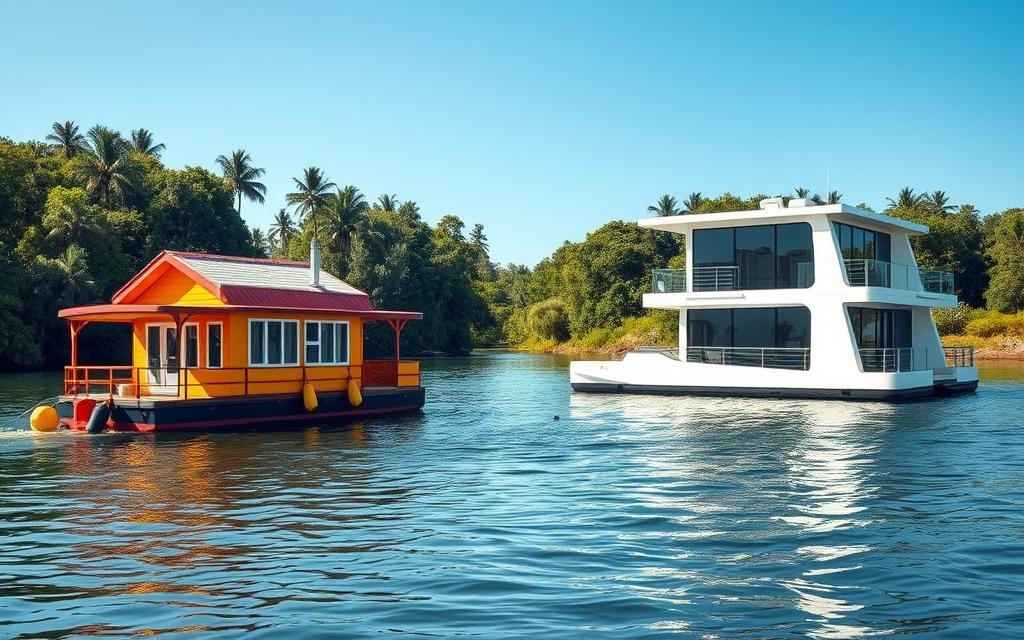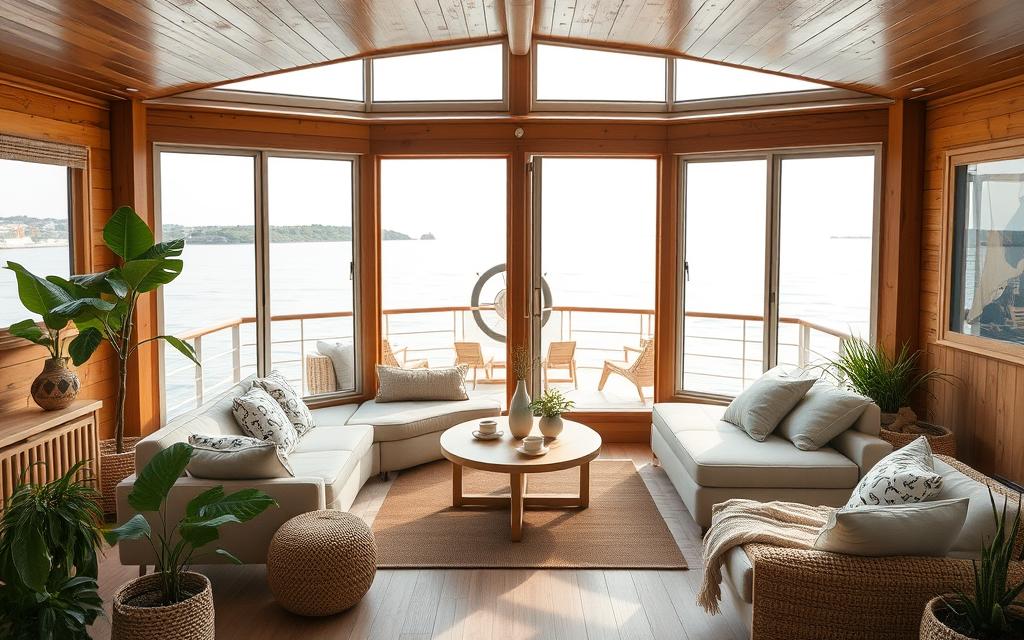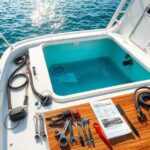Table of Contents
Ever thought about what makes a houseboat different from a floating home? Both offer a unique liveaboard lifestyle. But, they are much more distinct than many people think.

I’m passionate about living on the water. I’ve learned about the special features of residential boats. The choice between a houseboat and a floating home is more than just where you live. It’s about understanding their key differences.
Living on the water is more than just a place to live. It challenges old ideas about homes. From how easy they are to move to their design, these homes offer great alternatives to traditional houses.
Key Takeaways
- Houseboats and floating homes are not interchangeable terms
- Marine architecture defines unique characteristics of each dwelling
- Waterfront living requires understanding specific legal and structural considerations
- Mobility is a critical factor in choosing between these water-based residences
- Environmental impact varies between houseboats and floating homes
Understanding Waterborne Living Options
Water-based housing is a new way to live that changes how we think about homes. Aquatic dwellings offer a unique lifestyle that combines mobility with cozy living areas.
Water living has changed a lot over the years. Now, there are many floating homes for different tastes and needs. Let’s dive into the world of water-based housing.
Types of Water-Based Residences
Water-based housing comes in many types:
- Houseboats: Mobile homes for moving on water
- Floating homes: Fixed homes anchored in one place
- Marine apartments: Big floating homes for many people
- Portable water dwellings: Light, easy to move homes
Evolution of Aquatic Housing
Aquatic dwellings have a long history. Places like Amsterdam and Seattle led the way in water living. At first, these homes were for sailors and fishermen.
“Water is not a barrier, but a pathway to reimagining residential design.” – Urban Housing Innovator
Modern Water Living Trends
Today, water-based homes are more than just practical. They are modern, eco-friendly places to live. Architects and urban planners see them as real options for homes.
Now, people want homes that are sustainable and can move. These homes mix new design ideas with caring for the planet.
Houseboat vs Floating Home: Key Differences
Exploring waterfront living shows us the big differences between houseboats and floating homes. These special homes offer unique experiences for those who love the water.
Houseboats are like mobile homes that can move around. They mix living and fun, letting owners explore different places. On the other hand, floating homes stay in one place. They are fixed to the water in certain areas.
- Houseboats: Mobile living spaces with engine capabilities
- Floating Homes: Stationary dwellings connected to marina infrastructure
- Residential Use: Different legal and zoning requirements
Marina services are key in choosing between these homes. The rules for anchoring affect how each home works in the water.
| Feature | Houseboats | Floating Homes |
|---|---|---|
| Mobility | High (can navigate waterways) | Low (permanently anchored) |
| Legal Classification | Vessel/Recreational | Residential Property |
| Marina Requirements | Flexible docking | Fixed slip assignment |
“Water living offers a unique perspective on residential design and personal freedom.” – Maritime Living Magazine
Knowing these differences helps people choose the right water home. Each option has its own benefits for those who love living by the water.
Structural Design and Construction Methods
Exploring the world of floating homes and houseboats is fascinating. They are unique habitats that need special construction to be safe, comfortable, and last long.
Building Materials and Techniques
Building homes on water requires choosing the right materials. These homes use special materials that can handle the sea:
- Fiberglass reinforced hulls
- Marine-grade aluminum frameworks
- Corrosion-resistant composites
- Waterproof treated wood decking
Foundation Systems
For those who live on water, strong foundations are key. They need to be stable and flexible. The sea’s different environments call for different foundation types:
| Foundation Type | Key Characteristics | Best Suited For |
|---|---|---|
| Floating Platforms | Permanent, stable base | Urban waterfront locations |
| Pontoon Systems | Modular, adaptable design | Mobile residential watercrafts |
| Concrete Flotation | Heavyweight stability | Large marine living spaces |
Architectural Considerations
Designing floating homes needs creative thinking. Architects must make them both beautiful and practical. Spatial efficiency is key in these small homes.
“In maritime architecture, every inch matters. Design must harmonize with water’s dynamic environment.” – Marine Design Expert
Understanding these homes is about finding the right balance. It’s about how they look, work, and fit into their surroundings.
Mobility and Transportation Features

Looking into the mobility of nautical residences shows interesting differences. Houseboats and floating homes offer unique ways to travel. This affects how people live in these water homes.
Houseboats are true floating real estate with great mobility. They have special designs for moving on water:
- Integrated propulsion systems
- Navigational equipment
- Marine-grade engines
- Steering mechanisms
On the other hand, floating homes are fixed in one place. They stay anchored in marinas. Moving them requires special help:
- Professional towing services
- Specialized marine transportation barges
- Professional maritime movers
“The essence of water dwellings lies not just in their location, but in their ability to move and adapt.” – Maritime Housing Expert
Thinking about mobility is key when choosing a boat house or water home. Important factors include:
| Residence Type | Mobility Level | Location Flexibility |
|---|---|---|
| Houseboat | High | Multiple waterways |
| Floating Home | Low | Fixed marina location |
Knowing about these mobility aspects helps buyers choose the right nautical home. It ensures their home fits their lifestyle.
Legal Requirements and Regulations
Exploring the legal side of liveaboard vessels and residential watercraft can be tricky. It’s key to grasp the rules for those interested in maritime living. The rules for waterborne homes involve many steps and documents.
Looking into movable aquatic dwellings, owners face several legal hurdles:
- Licensing and registration processes
- Local and state zoning restrictions
- Comprehensive insurance requirements
- Compliance with maritime living regulations
Licensing and Registration
Different places have their own rules for houseboats. It’s wise to dig deep into local laws. Some places see houseboats as boats, while others treat them like houses. This changes how you register them.
Zoning Laws
Zoning laws play a big role in where you can live on a boat. Local areas often have strict rules about living on the water. Some welcome boat homes, while others have strict rules.
Insurance Requirements
Getting the right insurance for a boat home is special. Regular homeowners insurance won’t cover it. You need marine insurance to protect your boat home.
“Understanding legal requirements is as important as choosing the right watercraft.” – Maritime Living Expert
Those interested in boat living must tackle these legal issues. Each place has its own set of rules and chances for living differently.
Cost Comparison and Investment Value
Looking into water-based living means understanding the money side of it. Houseboats and floating homes have different costs and values. It’s important to think about these carefully.
Starting costs for homes on water can be very different. Floating homes usually cost more upfront but might grow in value more steadily. They can also keep their value better over time.
- Higher upfront purchase prices
- More consistent property appreciation
- Potential for long-term value growth
“Investing in a water-based dwelling isn’t just a lifestyle choice – it’s a strategic financial decision.” – Maritime Housing Experts
Marina berth rentals are key to the financial side of things. Annual costs include:
| Expense Category | Floating Home | Houseboat |
|---|---|---|
| Annual Berth Rental | $8,000 – $15,000 | $6,000 – $12,000 |
| Floating Home Insurance | $1,500 – $3,000 | $2,000 – $4,000 |
| Maintenance Costs | $2,000 – $5,000 | $3,000 – $7,000 |
Thinking about the boating lifestyle means looking at long-term money matters. Floating homes are more stable, while houseboats offer more freedom. Important things to consider are insurance, upkeep, and how much the value might go up in the marina market.
Utility Systems and Infrastructure
Living on water comes with its own set of challenges and thrills. As someone who’s into aquatic living, I’ve looked into the systems that power homes on water. These systems are key for a comfortable life on movable and stationary floating homes.
Power Sources for Liveaboard Boats
Water homes need different ways to get power. This keeps living conditions comfortable. The main sources are:
- Shore power connections at marinas
- Onboard generators
- Solar panel installations
- Battery bank systems
Water and Waste Management
Good water and waste systems are vital for living sustainably on water. Each type of water home has its own needs:
| Residence Type | Water System | Waste Management |
|---|---|---|
| Houseboat | Portable tanks | Self-contained marine toilets |
| Floating Home | Direct municipal connections | Standard plumbing hookups |
Communication Infrastructure
Staying connected on water needs creative solutions. Today’s liveaboard boats use:
- High-speed marine internet systems
- Satellite communication networks
- Cellular signal boosters
- Marine-grade communication antennas
“The key to successful water residence living is adaptable and resilient utility systems.” – Maritime Living Expert
Knowing about these systems helps future water home owners. It prepares them for a lifestyle that’s both mobile and tech-savvy.
Living Space and Interior Design

Designing living spaces in water homes needs creativity and planning. Maritime homes face challenges like limited space. They must be both comfortable and functional.
“In water-based living, every square inch counts and must serve multiple purposes.” – Nautical Design Expert
Waterfront homes have smart layouts to make the most of space. Designers use several strategies to make these spaces work:
- Multi-functional furniture designs
- Built-in storage solutions
- Vertical space utilization
- Lightweight, adaptable interior elements
Floating home rules affect how homes are designed. Architects must choose materials that are light, water-proof, and strong. This balance is key.
| Design Element | Maritime Home Consideration |
|---|---|
| Flooring | Water-resistant, lightweight materials |
| Furniture | Modular, secured designs |
| Storage | Integrated, space-saving solutions |
Designing water homes is about solving environmental challenges. It’s also about making a space that feels like home.
Environmental Impact and Sustainability
Looking into the environmental side of aquatic architecture shows us how to live green in marina communities. Houseboats and floating homes are new ways to cut down on harm to the planet. They let people live in a unique way that’s good for the earth.
Carbon Footprint Analysis
Living in houseboats is a chance to make a smaller mark on the environment. They use less land and materials than regular houses. Plus, they can run on clean energy.
- Reduced land consumption
- Lower construction material requirements
- Integrated renewable energy systems
Eco-Friendly Features
Today’s houseboats are built with green tech to lessen harm to nature. They have:
- Solar panels
- Rainwater catchers
- Small waste systems
Weather Resistance Strategies
Designing houseboats to last and fit with nature is key. New building methods make them strong yet gentle on the environment.
| Sustainability Feature | Environmental Benefit |
|---|---|
| Recycled Building Materials | Reduces waste and carbon emissions |
| Energy-Efficient Insulation | Minimizes energy consumption |
| Green Roof Systems | Improves thermal regulation |
“Sustainable living isn’t about sacrifice, it’s about intelligent design.” – Environmental Design Expert
Choosing green living in marina communities is smart. It’s a way to live in a houseboat responsibly. People can enjoy a new, eco-friendly way of life.
Conclusion
Exploring floating real estate has shown me that living on water is a special choice. It comes with its own set of benefits and challenges. Houseboats and floating homes offer unique living experiences that differ from traditional homes.
Choosing between a live-aboard vessel and a stationary floating home depends on personal needs and budget. Marine habitats offer exciting living options that break the mold of traditional housing. It’s important to think about mobility, infrastructure, and sustainability when considering these homes.
New technologies and urban design changes are making water-based living more appealing. As we become more aware of the environment and cities get smaller, floating homes could be a key to sustainable living. Those interested in this lifestyle need to be flexible and open-minded.
Knowing the differences between houseboats and floating homes helps people make better choices. While there are hurdles, the benefits of this lifestyle are worth exploring for those ready to face its challenges.
FAQ
What is the primary difference between a houseboat and a floating home?
Houseboats can move around and travel on waterways. Floating homes, on the other hand, stay in one place. Houseboats have engines to move, while floating homes are built to stay put.
Are houseboats and floating homes legal to live in full-time?
It depends on where you are. Some places allow living on houseboats or floating homes full-time. You need to check local laws and get the right permits. Some areas have rules about sanitation, insurance, and registration.
How do utility systems differ between houseboats and floating homes?
Floating homes usually have direct connections for electricity, water, and sewage. Houseboats have their own systems like tanks for water, toilets, and generators. This makes houseboats more flexible but needs more upkeep.
What are the typical costs associated with living on a houseboat or floating home?
Prices vary a lot. Floating homes can cost from $200,000 to over $1 million. You also pay $500-$3,000 a month for a mooring spot. Houseboats are cheaper to buy, but you’ll spend more on upkeep, fuel, and mooring.
How do environmental conditions impact these water-based residences?
Both types need to be built to last in the water. They face challenges like water damage and weather. Floating homes are more stable, but houseboats need more care because they’re always in the water.
Can I move a floating home to a different location?
No, moving a floating home is hard. It needs special equipment and planning. It’s expensive and not easy to do. Most stay where they were built.
What insurance considerations are unique to houseboats and floating homes?
Insurance for these homes is different. Houseboats need marine insurance for travel and safety. Floating homes have insurance like regular homes, but with extra coverage for water risks.
Are there financing options available for purchasing a houseboat or floating home?
Getting a loan can be tough. Traditional mortgages are rare. Some lenders offer marine loans, but they might ask for a big down payment and have high interest. Floating homes might get regular mortgages, but houseboats need special loans.



